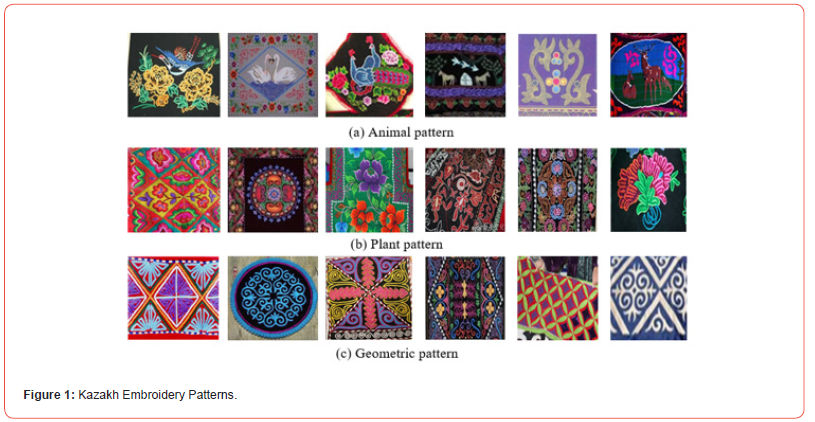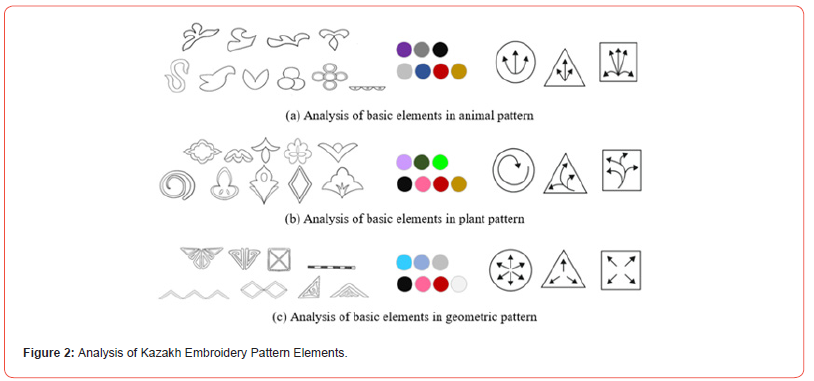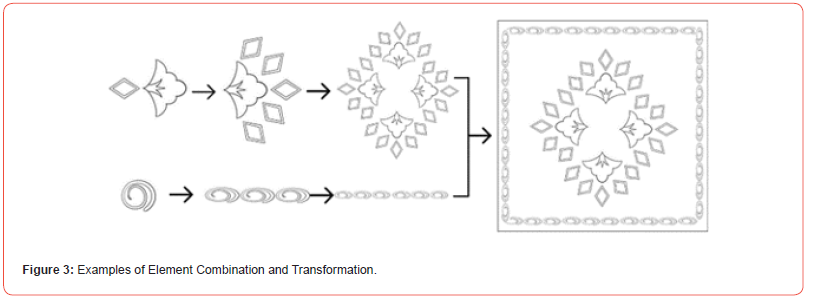 Mini Review
Mini Review
Analysis and Application of Basic Elements in Kazakh Embroidery Patterns
LI Zhou, HUANG Zirui, CHENG Yan and ZHAO Yu*
College of Sericulture, Textile and Biomass Sciences, Southwest University, China
ZHAO Yu, College of Sericulture, Textile and Biomass Sciences, Southwest University, Chongqing 400715, China
Received Date:September 13, 2024; Published Date:September 25, 2024
Abstract
The embroidery patterns of the Kazakh ethnic group reflect distinct national characteristics and regional features, possessing significant value for cultural inheritance and preservation. Current research on Kazakh embroidery patterns primarily focuses on cultural aspects, with limited attention to modern transmission and innovation. This study conducts an in-depth investigation into Kazakh embroidery patterns, collecting a large number of traditional designs. By incorporating the concept of pattern elements, it extracts patterns, colors, and compositional elements that exhibit typical Kazakh characteristics. Based on these elements, three series of modern patterns with Kazakh-style aesthetics were designed, aiming to provide new approaches and methods for the modern inheritance, preservation, and innovation of Kazakh embroidery patterns.
Keywords:Kazakh ethnic group; Embroidery patterns; Pattern elements; Textile designs
Introduction
The Ili Kazakh Autonomous Prefecture, located in the northwest of China, is home to various ethnic groups such as the Kazakh, Mongolian, and Xibe. These places have developed their own distinctive embroidery art, resulting in a rich diversity of decorative patterns. Among them, the embroidery patterns of the Kazakh ethnic group are the most representative. Common patterns include animals, plants, geometric patterns, and natural landscapes. These patterns not only reflect the unique cultural aesthetics of the Kazakh people but also reveal their living environment and traditional beliefs, holding significant cultural symbolism and practical value.
Current research on Kazakh embroidery patterns primarily focus on theoretical and applicable aspects. From the theoretical aspect, researchers focus on the historical background, cultural connotations, and symbolic meanings of the embroidery patterns. For example, Karimova introduced the historical background, cultural significance, and artistic features of Kazakh embroidery patterns [1]. On the applicable aspect, researchers aim to integrate traditional Kazakh embroidery patterns into modern design, such as in cultural and creative products, fashion design, and home decoration. For instance, Wei et al. analyzed the characteristics of Kazakh embroidery patterns and their application strategies in modern design, providing references on how to combine traditional culture with fashion design [2]. These studies have successfully bridged the inheritance and innovative application of Kazakh embroidery patterns, promoting the revival of these traditional designs in contemporary society and facilitating the organic integration of cultural heritage with market demands. However, challenges remain in the inheritance and innovation of Kazakh embroidery patterns. For example, the understanding of cultural background in modern design is sometimes inadequate, and the original cultural significance of the embroidery patterns is often diminished, resulting in a low rate of innovation and poor outcomes in terms of creative realization [3].
Based on this, the present study first provides an overview of the developmental trajectory and cultural background of Kazakh embroidery patterns. Then it analyzes representative embroidery patterns and conducts an in-depth exploration of their pattern elements. Finally, using these Kazakh embroidery pattern elements as a foundation, the study examines their innovative application in contemporary design. This research aims to offer new perspectives and references for the development of traditional embroidery art within the field of modern design.
Overview of Kazakh Embroidery Patterns
The cultural connotations embedded in Kazakh embroidery reflect the historical transformations of China. Over thousands of years, the development of a diverse cultural heritage has merged with the daily life of the Kazakh people, ultimately giving rise to embroidery that features compact and orderly compositions, bold and exaggerated patterns, vibrant and harmonious colors, freespirited stitching techniques, and a strong nomadic essence. This art form embodies the lifestyle and mindset of the Kazakh people and serves as a carrier of Kazakh culture [4]. Against this backdrop, the Kazakh ethnic group has developed its own unique embroidery patterns, which not only encompass the practical experiences of the Kazakh people but also embody their spiritual pursuits, imbued with a distinctive ethnic symbolism [5].
Kazakh embroidery uses natural fibers such as cotton and linen as raw materials, employing techniques such as satin stitch, buttonhole stitch, and chain stitch, resulting in a wide variety of unique and intricate patterns. The embroidery patterns are primarily composed of animal patterns, plant patterns, and geometric patterns. The colors of different patterns are harmoniously coordinated, reflecting the Kazakh people’s aspiration for natural harmony and a beautiful life [6]. These embroidery patterns are applied to various aspects of Kazakh daily life, including bedding, beds, clothing, shoes, and interior decorative items, infusing their everyday environment with a strong exotic charm.
Analysis of Basic Elements in Kazakh Embroidery Patterns
Through a review of books and literature, it is evident that Kazakh embroidery patterns predominantly feature animal, plant, and geometric patterns. Regarding animal patterns, in ancient times, the Kazakh people revered many animals such as sheep, horses, cattle, owls, and swans, all of which were closely connected to their living environment, forming a special emotional bond. The Kazakh people often use wings, skeletons, and horns of animals as important elements in creating embroidery patterns, reflecting their admiration for nature and their constant adherence to the natural order and aesthetic principles (Figure 1a). In terms of plant patterns, common patterns include almond, pomegranate, lotus, grape, and willow branch designs, as well as patterns formed by the combination of scrolls and flowers. These typical plant patterns carry different meanings, such as prosperity, happiness, celebration, unity, and a carefree life. These distinctive patterns are not only visually elegant but also carry profound symbolism, captivating viewers (Figure 1b). As for geometric patterns, the Kazakh people often draw inspiration from various shapes and structures found in nature. Through abstraction and simplification, they create patterns that are both decorative and aesthetically pleasing. Basic shapes such as triangles, circles, squares, and rectangles in Kazakh embroidery can be combined into intricate designs, and through the use of different color combinations and flowing lines, they produce dynamic and three-dimensional effects (Figure 1c).

The analysis of Kazakh embroidery pattern elements primarily focuses on three aspects: pattern elements, color elements, and compositional elements [7]. First, the pattern elements of Kazakh animal embroidery patterns exhibit a distinct simplified appearance of animals, such as the abstraction of geese and birds. The color elements are predominantly warm tones, with generally low brightness, while the compositional elements are mainly centered on symmetrical arrangements (Figure 2a). Second, the pattern elements of Kazakh plant embroidery patterns feature a clear simplified appearance of plants, primarily flowers and grasses, with flowing lines that exude a sense of beauty. The color elements are mainly cool tones, with generally high brightness, and the compositional elements are primarily based on balanced symmetry (Figure 2b). Finally, the pattern elements of Kazakh geometric embroidery patterns are characterized by distinct linear features, sharp edges, and precise structure. The color elements also favor cool tones, with generally high brightness, and the compositional elements are mainly focused on radial symmetry (Figure 2c).

Application of Basic Elements in Kazakh Embroidery Patterns
Through the analysis of Kazakh embroidery pattern elements, we can gain a deeper understanding of the art and culture of Kazakh embroidery patterns. More importantly, this approach facilitates the rapid design of new pattern types with Kazakh-style characteristics by reorganizing these elements, allowing them to better integrate into modern mainstream culture. There are two methods for pattern design based on elements: the first is direct application, where the elements are filled into a pre-arranged framework; the second involves reorganizing and transforming the elements before applying them to new patterns (Figure 3) [8].

Figure 4 presents a series of new patterns generated by reorganizing selected representative Kazakh embroidery pattern elements. These patterns incorporate animal, plant, and geometric elements, which have been reorganized and redesigned through methods of central symmetry, balanced symmetry, and radial symmetry. By pairing these with traditional color schemes, the resulting designs form new Kazakh embroidery patterns that are delicate in style and rich in layers.

Conclusion
This study explores the application of Xinjiang Kazakh embroidery patterns in modern design, as well as their role in the inheritance and innovation of China’s outstanding traditional culture. Kazakh embroidery holds an important position in the transmission of Chinese culture and continues to evolve through innovation, combining traditional art with modern design, thereby injecting new vitality into the preservation and development of Kazakh culture. Furthermore, to promote the flourishing of Kazakh embroidery patterns, it is essential to enhance research on their historical and cultural connotations to elevate their cultural value. Additionally, the application of Kazakh embroidery patterns in modern design should be strengthened, promoting the creative transformation and innovative development of China’s outstanding traditional culture.
Acknowledgement
None.
Conflict of interest
The authors declared no potential conflicts of interest with respect to the research, authorship, and/or publication of this article.
References
- Karimova RU (2016) On History of Cultural Traditions Transformation: Arts and Crafts of the Uyghurs of Kazakhstan. Oriente Moderno 96(1): 3-24.
- Wei P, Xiang M (2024) Research on Architecture and Decoration Design of Kazakh Ethnic Residential Buildings in Ili. Frontiers in Art Research 6(5).
- Owen J, Kolawole W (2024) Topic: Consequences of Insufficient Technological Integration on the Teaching and Learning of Computer Science.
- Saylauovna KR (2022) Kazakh Literature and Its Brilliant Representatives. Galaxy International Interdisciplinary Research Journal 10(1): 118-121.
- Alzhanov G, Ermakhanbetova A (2022) The Genesis of the Development of Ecodesign in the Art of Embroidery. Pedagogy and Psychology 52(3): 83-95.
- Zhubanova Z (2021) Kazakh ornament: from traditions to the new combinations of shapes in contemporary art. Pedagogy and Psychology 46(1): 195-203.
- Xu C, Bai X, Ruan D, Zhang C (2024) Comparative finite element analysis of posterior short segment fixation constructs with or without intermediate screws in the fractured vertebrae for the treatment of type a thoracolumbar fracture. Comput Methods Biomech Biomed Engin 27(11): 1398-1409.
- Li B, Li Z, Zhang J, Sun G, Mei J, et al. (2023) Channel transformer U-Net: an automatic and effective skeleton extraction network for electronic speckle pattern interferometry. Appl Opt 62(2): 325-334.
-
LI Zhou, HUANG Zirui, CHENG Yan and ZHAO Yu*. Analysis and Application of Basic Elements in Kazakh Embroidery Patterns. J Textile Sci & Fashion Tech 10(4): 2024. JTSFT.MS.ID.000751.
-
Kazakh ethnic group, Embroidery patterns, Pattern elements, Textile designs
-

This work is licensed under a Creative Commons Attribution-NonCommercial 4.0 International License.






